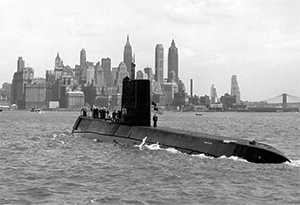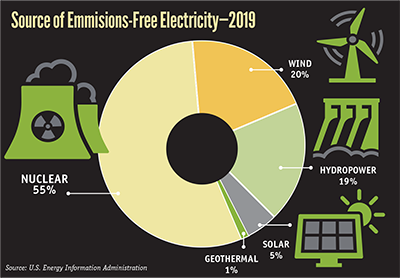The United States has the largest nuclear fleet in the world with 94 commercial operating reactors at a combined capacity of 97,154 megawatts electric (MWe). The nation produces more electricity from nuclear power than any other single country and contributes more than 30% of the world’s nuclear electricity generation capacity.
As of 2019, the next closest country is France with 56 reactors generating 61,370 MWe of power, accounting for more than 70% of that country’s electricity generation needs. Meanwhile, other countries, such as China and India, continue to build and push for nuclear power hoping to take advantage of this reliable clean energy source.
Nuclear power once seemed an unlikely partner to the idea of clean energy; nuclear doesn’t appear to be a factor in providing cleaner energy and reduced air pollution. However, this source of energy has been a safe, reliable source of carbon-free electricity for decades. Even when the sun isn’t shining or the wind isn’t blowing, nuclear power keeps producing carbon-free power, using technologies that focus on safety, reliability and economical operation. To better understand why it’s a necessary resource in meeting our clean energy needs, we must understand the origins of the industry.
THE HISTORY OF NUCLEAR
The story of America’s nuclear power industry includes a young Polish immigrant named Hyman G. Rickover—or as he is better known—Admiral Rickover. Rickover’s actions fathered the U.S. Naval Nuclear Propulsion Program.
Admiral Rickover served in the U.S. Navy from the time of his graduation from the United States Naval Academy in 1922 until his retirement in 1982, and he spent most of his career advocating for nuclear technology and power. Because of Admiral Rickover, the beginnings of commercial nuclear power plants and the U.S. naval submarine program are intertwined. During a visit to the Oak Ridge National Laboratory in 1946, Admiral Rickover observed work on a nuclear electric-generating plant, which inspired his vision for a fleet of submarines and ships powered with nuclear energy. As he began to share his vision with others in the navy, he garnered support to begin developing nuclear power for submarine propulsion, as well as for commercial electricity operation.
Admiral Rickover was responsible for overseeing the development of both the nuclear-powered submarine and the first full-scale commercial nuclear power plant. In 1949, he continued his focus on nuclear by serving in two government roles simultaneously—director of the Nuclear Power Division, Bureau of Ships, and chief of the Naval Reactor Branch, Reactor Development Division, Atomic Energy Commission (the predecessor to today’s Nuclear Regulatory Commission).
During his career, safety and discipline were of utmost importance to Admiral Rickover. For example, in developing the nuclear submarine, he created a culture of accountability and procedure that ultimately led to the success of the naval and civilian nuclear power programs. His extensive focus on safety and reliability for nuclear machinery led to demands that even completely-built equipment and prototypes needed to be discarded if they were considered flawed or had poor workmanship. Engineers working for Admiral Rickover adopted this attitude, using careful and precise engineering in the development of the first full-scale nuclear power plant.
Because of this, Admiral Rickover can be credited as the force behind creating a safety culture that has led to the lack of any major U.S. Navy reactor accidents. This intense focus on reliability carried over as the naval nuclear program gave birth to the civilian nuclear power program beginning with the first full-scale nuclear power plant for civilian use—the Shippingport Nuclear Power Plant, which started up in 1957 and operated until 1982. The success of that plant led to larger, more economical nuclear power plants that could produce more electricity to power more homes and businesses.
Today, nuclear power prevents 573 million tons of carbon dioxide emissions from being released each year. The industry provides over 475,000 full-time direct and secondary jobs, and has a stellar safety record with the Occupational Safety and Health Administration, with significantly lower recordable incidents than other industrial workplaces. Over 28 states use nuclear power plants. In fact, nuclear generates 55% of the power in Illinois, half of the power in South Carolina and 40% of the power in Connecticut.
Nuclear power has been operating since the 1990s at over an 80% capacity factor, a measure that indicates how fully a unit’s capacity is used. In 2019, the industry achieved a 93% capacity factor, making it significantly more reliable than other forms of power generation. This reliability ensures critical operation of infrastructure such as hospitals, airports, schools and water/sewage plants. Comparatively, renewables such as solar and wind had a capacity factor of 24% and 34% respectively in 2019.
This gap is why nuclear is so important in complementing those renewables.
A BRIGHTER FUTURE
Admiral Rickover wasn’t the only one looking toward the future in the 1940s—the invention of the transistor occurred in 1947 and the digital revolution developed alongside the nuclear industry (continuing to rapidly accelerate over the years). In the 70 years since the launch of the USS Nautilus (the first nuclear-powered submarine), we have moved from transistors to pagers, pagers to smart phones, and smart phones to virtual reality technology. As we become more reliant on technology and populations continue to expand, it is highly likely that power generation will need to rise to meet increasing demands.
On top of this increased energy demand, more and more countries are committing to become carbon-free or carbon-neutral within the next 30 years. With mandates such as California’s goal to ban sales of gas-powered cars by 2035 applying pressure for cleaner, more efficient systems, it has become increasingly apparent that achieving carbon reduction goals is going to need the reliability of nuclear.
One reason is that nuclear is currently the largest source of carbon-free energy in America. In 2020, the industry produced 55% of America’s clean energy (20% of all American energy). This doesn’t mean nuclear must be the singular answer to America’s carbon woes. The reliable nature of nuclear pairs perfectly with renewables that rely on certain conditions to produce power. This partnership between nuclear and other sources increases the flexibility of the nation’s power grid, allowing for large shifts such as the potential virtual power grid proposed in California and smaller-scale operations such as microgrids and vehicle grids.
The nuclear industry also continues to rise to the challenge of increased safety, reliability and cost effectiveness, developing technology to meet growing demands and future expectations. Every stage and phase of the nuclear process is under examination for potential advancements and improvements, ranging from process innovations such as 3D scanning for plant inspections, using augmented and virtual reality products for training and troubleshooting, and producing hydrogen from nuclear processes to product innovations such as new fuel types, fail-proof reactor designs and small modular reactors (SMRs) and advanced reactors (ARs).
SMRs and ARs represent both the future of the nuclear industry and the opportunity for reliable, sustainable power, even for areas that may not have access to other renewable sources. Helped along by government programs, these reactors have a lower capital investment, a smaller physical footprint and a larger variety of site options, all of which have been long-term issues of the conventional nuclear power industry. This flexibility means they also can be used in conjunction with other renewables, maximizing potential space and output power even when conditions are less than ideal for those other power sources. There are several designs currently circulating in the market, each of which has their own unique features and advantages. All of them possess the same eye for safety that Admiral Rickover fostered in the commercial and naval nuclear power industry.
Companies such as NuScale, TerraPower, GE-Hitachi, X-energy, Oklo, Kairos, the Ultra Safe Nuclear Corporation (USNC) and others have reactors in the planning that can be deployed by the late 2020s or the early 2030s. These reactors live up to the imperative for a clean, safe and reliable source of carbon-free electricity.
In late 2020, NuScale’s Power Module became the first NRC-approved SMR design, receiving a cost-share award from the Department of Energy under the Carbon Free Power Project. Other SMR and AR designs are further away, but still viable in the next 10 years. Fast neutron reactors (FNRs) have better fuel efficiency and longer refueling cycles, with some having the capability of running off recycled fuel from traditional power plants. Other options such as high-temperature gas-cooled reactors (HTGRs) and modified light water reactors (LWRs) use more traditional methods, but with innovations.
No singular solution to meeting America’s carbon goals or to an entirely clean energy grid exists. However, the demand for safe, clean and reliable energy will only increase alongside population numbers and technological advancements, meaning we need to take steps now to preserve the future. Renewables alone are not enough to meet the needs of our grid while also hitting carbon emission goals because they lack the reliability nuclear offers. By supporting initiatives such as small modular and advanced reactors used in conjunction with renewables, a more sustainable future is within grasp.
JULIO ADAME (jadame@curtisswright.com) is director of marketing at Curtiss-Wright’s Nuclear Division (www.cwnuclear.com), Brea, CA. He received an MBA from the University of Southern California. BRENNA WOLFE (bwolfe@curtisswright.com) is a technical writer at Curtiss-Wright’s Nuclear Division. She holds a BA from California State University, Fullerton.
Additional Sources:
1. Hyman G. Rickover | Atomic Heritage Foundation (https://www.atomicheritage.org/profile/hyman-g-rickover)
2. History of Nuclear Energy - World Nuclear Association (https://www.world-nuclear.org/information-library/current-and-future-generation/outline-history-of-nuclear-energy.aspx)
3. Electric Power Monthly - U.S. Energy Information Administration (https://www.eia.gov/electricity/monthly/epm_table_grapher.php?t=epmt_6_07_b)
4. Duncan Rickover and the Nuclear Navy (https://www.energy.gov/sites/prod/files/2018/04/f50/DuncanRickoverandtheNuclearNavyComplete_1.pdf)
RELATED CONTENT
-
Hardfacing for Valves: Materials and Processes
Valve internals, such as seats and closures, are often at risk of erosion, abrasion, corrosion, galling and damage from cavitation.
-
Effective Check Valve Selection and Placement for Industrial Piping Systems
When planning a check valve installation, the primary goal is to achieve a valve and piping system that offers the longest service life at the lowest cost.
-
The Different Types of Solenoid Valves and How They Work
Solenoid valves are automatic flow control devices popular across different industrial applications.















 Unloading large gate valve.jpg;maxWidth=214)